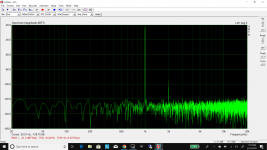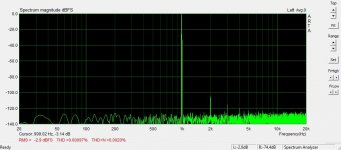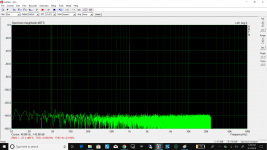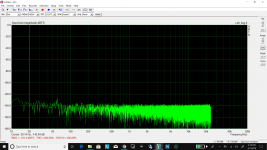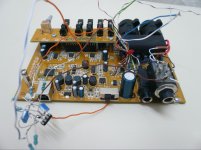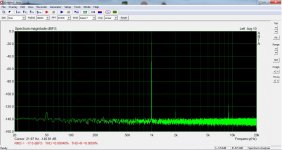I was going to effusively report lower noise figures after Cu shielding and grounding the shaft last night, but at the end of it I thought it'd be "interesting" to use the wrong supply (identical jack) - 12V from my headphone amp - to supply it.
I would start by checking the input and output voltages on the DC-DC converter. The data sheet says the absolute maximum input voltage is 10V, so it may have been damaged from having 12V applied to it.
Well, that's interesting. It seems the part I would have bet some good money would withstand this if any part would, failed - the ESD protection diode. It would short the power supply through the fuse, and keep the interface offline.
Anyway, I seem to have lowered THD+N by about 0.01%. I used copper foil for shielding, and grounded also the shaft. Is this what others have observed?
I will go next to the caps suggested.
Anyway, I seem to have lowered THD+N by about 0.01%. I used copper foil for shielding, and grounded also the shaft. Is this what others have observed?
I will go next to the caps suggested.
Attachments
Last edited:
Another data point / Sound Card
I just completed Peter Millett's sound card interface. Still on the learning curve with ARTA and calibration. The only addition was to use copper tape to line the upper half of the box.
I am using an ASUS Essence STX II sound card. The following is the spectrum looped back through the sound card interface.
Still have to calibrate the AC RMS voltmeter and continue exploring this setup.
Regards,
M
I just completed Peter Millett's sound card interface. Still on the learning curve with ARTA and calibration. The only addition was to use copper tape to line the upper half of the box.
I am using an ASUS Essence STX II sound card. The following is the spectrum looped back through the sound card interface.
Still have to calibrate the AC RMS voltmeter and continue exploring this setup.
Regards,
M
Attachments
2) Added the following ceramic capacitors in order to suppress noise:
1uF - 5V supply (soldered straight on USB socket PCB terminals);
0.1uF - parallel to C22, C7, C8 (near Murata switch mode DC-DC converter);
1uF - parallel to C13, C18, C11.
0.1uF - high quality ceramic NP0 type
1uF - ceramic Z5U type
Choke would be the last option if anything above doesn't work, DC 500mA 10-12mH is quite big, it doesn't fit nicely.
4 terminal chokes (from many switch mode PS) are common mode types, they are not suitable for this application.
Now in loopback mode I've got the following (1.9V from ESI Juli, balanced connections, 192000 mode, 191072 FFT):
1 KHz: THD - 0.0075%, THD+N - 0.082%
20 Hz: THD - 0.041%, THD+N - 0.19%
20 KHz: THD - 0.048%, THD+N - 0.094%
SMPTE IMD 250Hz/8KHz - 0.035%, MD2 - 0.034%, MD3 - 0.0038%
50 Hz noise: -104dB
100 Hz noise: -120dB
150 Hz noise: -120dB
LinuksGuru - thank you, this sinks the floor down quite a bit. Need to look at this more, but I'm tempted to say this, plus running the interface on batteries lowered the noise floor of the interface enough to no longer be the bottleneck between it and my E-MU 0404. I see something very close to 140dB now, both of them in the loop.
Why do this if running on batteries? I suspect my garage is a very noisy environment - dealing with all sorts of gremlins elsewhere - and so anything environmental is likely shunted to ground by doing this. Ah, and there's the DC/DC converter.
Attachments
For anyone looking at my spectrum snips, my fundamental is never at 0dB, but always at lower than -20dB. I obviously still need to work on calibrating this setup, and can't wrap my head around it. I've never seen my fundamental at 0dB this far, as much as I've tried. ARTA is still very cryptic to me, especially when both a sound card and the PM interface are involved at the same time.
How go about it? Is there a good tread or resource I should read before hand?
How go about it? Is there a good tread or resource I should read before hand?
Last edited:
I don't think it has to do with ARTA and calibration. You have to provide the ADC inputs enough signal to drive them at full scale. I don't know how does your soundcard works but it could help to check input/output levels.
I am keeping the input on the interface/soundcard (if-SC) at a minimum, which reportedly provides a minimum of noise - which is also my observation - and it doesn't short the input to ground (E-MU 0404). Now, in circuit there's also Pete Millett's interface (if-PM). Now that everything else is stabilized and I'm done for now with improvements, I'm going back to the issue of levels/calibration and it doesn't feel I sorted that out (nor, really, wrapped my head around ARTA/if-SC/if-PM).
For instance, I feel my noise levels are correct (being around 120-140dB), but why is my fundamental at less than -20dB? Given the relative difference between the two of less than 80dB, does that mean my noise floor is actually at -80dB? Hm.
For instance, I feel my noise levels are correct (being around 120-140dB), but why is my fundamental at less than -20dB? Given the relative difference between the two of less than 80dB, does that mean my noise floor is actually at -80dB? Hm.
I think you can get too hung up on this. My fundamental was always less than -20dB too. As long as you're getting the noise level that you are I wouldn't worry about it.
I moved on to measuring actual amplifiers and it doesn't matter.
Say I'm doing measurements at 1W. I adjust the level from ARTA to give me the appropriate voltage on my meter (more accurate than the built-in metre). You'll need to have the Pete Millett range set to 2V. I just go ahead and do the measurements.
I've measured lots of amps now both solid-state and tube and wish I hadn't wasted all the time in the beginning worrying about the -20dB level and absolute noise levels in soundcard loopback and PFiF Gen Mon mode.
You're ARTA plots look fine to get stuck in to measuring real equipment.
120-140dB should be the target point for a 24bit digital converter. But the real noise floor actually seems to be at -80dB and that's because the input preamps. Obviously, these are too noisy -too much gain? What I said in my previous post derives from a project I'm currently messing with. Soon I'll be able to post results, success or failure...For instance, I feel my noise levels are correct (being around 120-140dB), but why is my fundamental at less than -20dB? Given the relative difference between the two of less than 80dB, does that mean my noise floor is actually at -80dB? Hm.
What are the recommendations for sound cards currently available, USB or PCIe?
Is there any reason PCIe sound cards would be preferred to USB?
One reason I find the PCIe appealing is that I have enough "boxes" around my PC workstation and putting a card inside won't add to the clutter. Although, the options seem limited.
Here are a few I've found within my price range that could work:
1) Focusrite Scarlett 2i2
2) eSI MAYA44 eX (PCIe)
3) Behringer U-Phoria UMC202HD
Thanks
Is there any reason PCIe sound cards would be preferred to USB?
One reason I find the PCIe appealing is that I have enough "boxes" around my PC workstation and putting a card inside won't add to the clutter. Although, the options seem limited.
Here are a few I've found within my price range that could work:
1) Focusrite Scarlett 2i2
2) eSI MAYA44 eX (PCIe)
3) Behringer U-Phoria UMC202HD
Thanks
Focusrite has known issues with windows drivers ( OK on MAC). Other than that seems to be be the first choice out there. I don't know about ESI but is a highly respected brand. I can tell about UMC202HD. In stock form is not suitable for the job, you will be disappointed. But with a few tweaks it enters Focusrite territory. I'm "working" on it... However, it has to be said that it is for hard core DIYers!
Thanks for your insight. That rules out the Behringer for me.
I typically use Windows but have a MAC from work so maybe the Focusrite could still work for me. What are the issues with the drivers? How does it impact measurements?
Is there a different card that is recommended for Windows under $200 ?
I typically use Windows but have a MAC from work so maybe the Focusrite could still work for me. What are the issues with the drivers? How does it impact measurements?
Is there a different card that is recommended for Windows under $200 ?
Focusrite has known issues with windows drivers ( OK on MAC). Other than that seems to be be the first choice out there. I don't know about ESI but is a highly respected brand. I can tell about UMC202HD. In stock form is not suitable for the job, you will be disappointed. But with a few tweaks it enters Focusrite territory. I'm "working" on it... However, it has to be said that it is for hard core DIYers!
Would you be able to start a separate thread and expand on the tweaks for the UMC202HD thou refer to?
What's the back story? Intrigued, so I'd appreciate further detail. Thanks.
No personal experience with Focusrite but it is reported to freeze in the middle of the procedure and need to restart. I don't have any recommendations at the moment as I myself trying to find something. Far from $200, I've set the limit to $100 that's why I put my hands on a UMC202HD...Thanks for your insight. That rules out the Behringer for me.
I typically use Windows but have a MAC from work so maybe the Focusrite could still work for me. What are the issues with the drivers? How does it impact measurements? Is there a different card that is recommended for Windows under $200 ?
I've playing with this in my limited spare time. First findings are encouraging. I'll post the story for sure, I just need some time. Meanwhile here is a preliminary stage to help you decide if you are willing to go into something like this.Would you be able to start a separate thread and expand on the tweaks for the UMC202HD thou refer to?
What's the back story? Intrigued, so I'd appreciate further detail. Thanks.
Attachments
I, too, have a UMC202HD. I use this for speaker/room measurements and was looking at options for a secondary sound card that would be relegated solely to electronics measurements (if for no other reason than for me not to have to remember where the knobs are set for each application as I change the from speaker to electronics measurements). Most likely I'll purchase the focusrite 2i2. But, having said that, I'd still be curious to know what your end results and how you got there are, MagicBus.
Trying to debug an issue with my recently built interface.
Unit is assembled and seems to be working (generally).
I went through both calibrations.
The issue I have is with the digital meter. In the 2V range, it seems to be OL above 1V.
For example, if I have a reading of 1.5V in the 20V range, rotating the knob to the 2V shows "1. V"
Any ideas?
Unit is assembled and seems to be working (generally).
I went through both calibrations.
The issue I have is with the digital meter. In the 2V range, it seems to be OL above 1V.
For example, if I have a reading of 1.5V in the 20V range, rotating the knob to the 2V shows "1. V"
Any ideas?
Trying to debug an issue with my recently built interface.
Unit is assembled and seems to be working (generally).
I went through both calibrations.
The issue I have is with the digital meter. In the 2V range, it seems to be OL above 1V.
For example, if I have a reading of 1.5V in the 20V range, rotating the knob to the 2V shows "1. V"
Any ideas?
I've got an auto-ranging DMM - pretty cheap (2nd DMM an option?). No experience with your issue.
- Home
- Design & Build
- Equipment & Tools
- Test & Measurement interface for Soundcard
